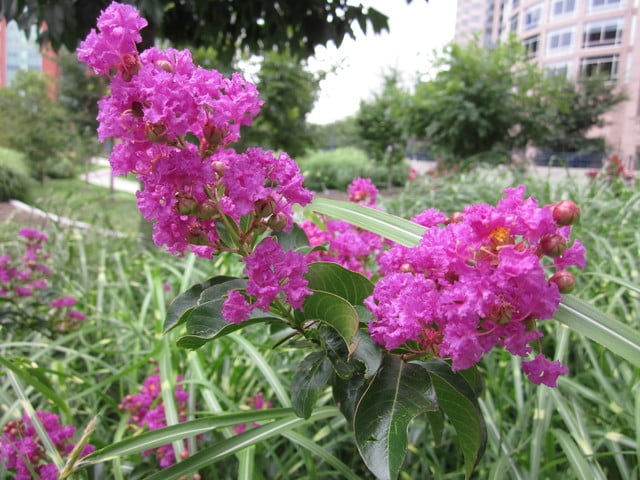
By Steve Boehme





One of our strongest impressions from travels in the South is the abundance of showy Crape Myrtle shrubs and trees everywhere.
In cities like Charlotte and Atlanta, we see lots of Crape Myrtle trees more than 10 feet tall, most often multiple trunk clumps with the lower branches removed to show off the handsome bark and interesting branch structure of this distinctive tree.
Up north, it’s harder to get this effect, because the tree will often freeze back and have to regrow from the ground up.
Crape Myrtle is a woody shrub or small specimen tree that will behave like a perennial in northern climates, often dying back to the ground in winter only to reappear when the weather gets warm. The Ohio Valley is on the northern edge of hardiness for Crape Myrtle, but some Crape Myrtle varieties can be successful here if care is taken to protect them from the harsh winters we get occasionally.
Crape Myrtles are often the last plants to re-emerge in spring. They can appear dead, and, in fact, may have lots of winter-kill, but eventually, you’ll see fresh green shoots springing from the ground.
These will grow rapidly in a single season and then flower on the new growth. Simply cut off the dead wood, fertilize and you’ll be rewarded with bloom by late summer.
Some varieties are hardier than others; it’s important to check the hardiness zone on the label before buying. Our bloom season is much shorter here, so instead of year-round color, we can only have bloom from midsummer until first frost.
Most Crape Myrtle varieties are hardy in Zone 7 or warmer, but southern Ohio is in Zone 6a. A harsh winter can bring root temperatures below 0 and most Crape Myrtle varieties will not survive.
At our nursery, we carry only Zone 6 or Zone 5 Crape Myrtle cultivars. These will withstand most Ohio Valley winters if they have protection from winter wind, in locations where the ground doesn’t stay frozen for long periods. Typically this would be the east or southeast side of your home, in a sunny spot (Crape Myrtles do best in full sun all day).
Realistically, southwest Ohio weather won’t permit most Crape Myrtles to become tree-sized. The label may say that a particular variety grows 12 to 25 feet tall, but here in Ohio, it will probably only reach shrub size.
Shrub-form Crape Myrtles are a better approach for Ohio. Most are on the large side, from six to 10 feet tall and wide, but dwarf forms are available.
The Cincinnati Zoo & Botanical Garden has several mature “Tonto” Crape Myrtles, in sheltered locations. Many homes along the Ohio River boast large, showy Crape Myrtle in their landscapes, since the river offers a more temperate micro-climate.
We carry “Dynamite,” a red variety that is fairly hardy in the Ohio Valley. We also have “Enduring Summer,” a new “re-blooming” variety with bright red blooms. The “Filli” series is a low-growing form hardy to Zone 5, a better bet for Ohio than most Crape Myrtles. “Pocomoke” is a more compact shrub form with a tidy mounding shape that fits well in foundation plantings and perennial gardens. In late summer it makes a gorgeous display, reminiscent of azaleas, when most shrubs are looking a bit tired from the heat.
Crape Myrtles are a taste of the South, very interesting accent plants. We would be cautious about depending on them as the backbone of an Ohio landscape, but they can thrive here in the right setting.
If you’re nostalgic about Crape Myrtle you’ve seen south of the Mason-Dixon Line, you might want to add one to your landscape.
Steve Boehme and his wife, Marjorie, own GoodSeed Nursery & Landscape, located at 9736 Tri-County Highway, near Winchester.
ID, 'source', true); $sourcelink = get_post_meta($post->ID, 'sourcelink', true); $sourcestring = '' . __('SOURCE','gabfire') . ''; if ($sourcelink != '') { echo "
$sourcestring: $source
"; } elseif ($source != '') { echo "$sourcestring: $source
"; } // Display pagination $args = array( 'before' => '' . __('Pages:','gabfire'), 'after' => '
', 'link_before' => '', 'link_after' => '', 'next_or_number' => 'number', 'nextpagelink' => __('Next page', 'gabfire'), 'previouspagelink' => __('Previous page', 'gabfire'), 'pagelink' => '%', 'echo' => 1 ); wp_link_pages($args); // Display edit post link to site admin edit_post_link(__('Edit','gabfire'),'','
'); // Post Widget gab_dynamic_sidebar('PostWidget'); ?>